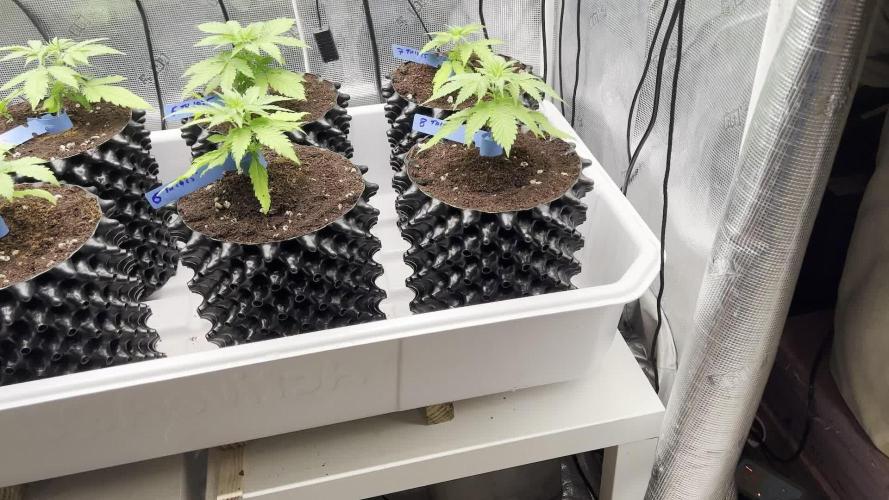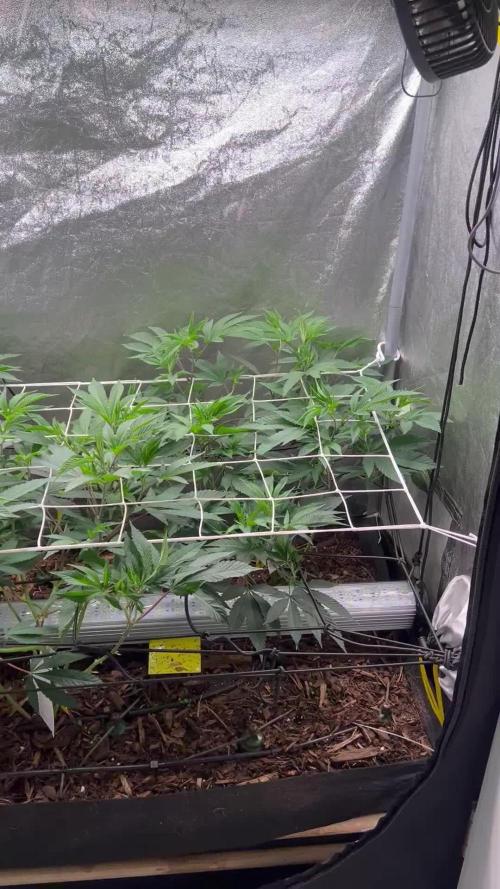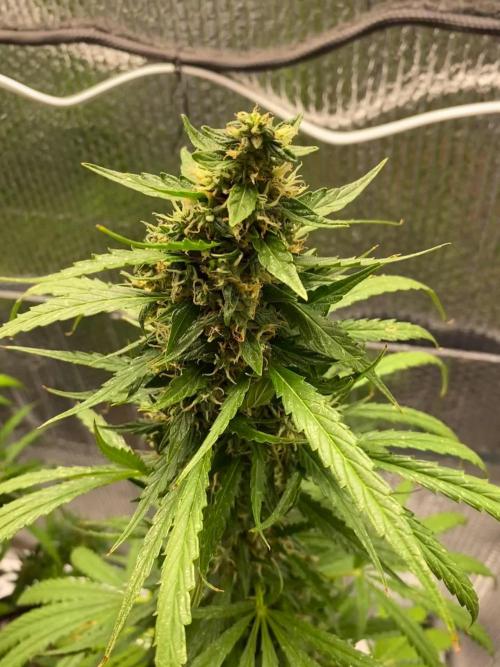The Grow Awards 2026 🏆 































Likes
Comments
Share


@MadeInGermany
Follow
Hey guys :-)
The lady developed beautifully this week :-) .
She's starting to grow a lot.
Next week I will repot them in 8 liter cloth pots.
Watering was done twice this week with 0.5 l each.
Since I partially washed the earth beforehand so that there are hardly any nutrients, I have a small layer of vomit Added Green House Powder Feeding.
So she has a few nutrients until repotting :-) .
Otherwise everything was cleaned.
I wish you a lot of fun with the update and stay healthy 💚🙏🏻
👇🏼👇🏼👇🏼👇🏼👇🏼👇🏼👇🏼👇🏼👇🏼👇🏼👇🏼👇🏼
‘Powered by GreenHouse Feeding’
Copy the link for 10% off all Nutrients 👇🏼
https://shop.greenhousefeeding.com/affiliate/MadeInGermany_PassionGrower
👇🏼👇🏼👇🏼👇🏼👇🏼👇🏼👇🏼👇🏼👇🏼👇🏼👇🏼👇🏼
You can buy this strain at :
https://www.amsterdamgenetics.com/product/choco-cheesecake/
👇🏼👇🏼👇🏼
Use the coupon code: madeingermany
for 10% on all Amsterdam Genetics seeds
Water 💧 💧💧
Osmosis water mixed with Cal/Mag (24 hours stale that the chlorine evaporates) to 290 ppm and Ph with Ph- to 5.8 - 6.4
MadeInGermany
Likes
27
Share


@Nevinkush99
Follow
Yellow tips otherwise all good
Idk if its nute burn or other issue trying to get it fixed 😄
Likes
33
Share


@Ju_Bps
Follow
Hello my friends growers,
Week was good,
Buds look stoped to grow up, so i'll start pk 13-14 next week,
I've start to give tera flores and sugar royal this week.
Plant look healthy and buds look nice with lot of pollen, it will be probably a sticky weed :).
Have a good week mate growers, see you next week 😘
Likes
Comments
Share


@BIYEI
Follow
Vegetativo 29-11-2024 a 05-12-2024
Semana 2
29-11-2024 La planta manifesto un crecimiento considerable, se ve sana y fuerte.
01-12-2024 Se realiza cambio de solucion nutritica y recipiente hidroponico.
03-12-2024 La planta crecio desmesuradamente durante estos dias, pero noto que necesita algo de CALMAG.
05-12-2024 Sorprendente evolucion.
Parametros Utilizados
Temperatura del ambiente 22 C°
Extraccion de aire 4 pulgadas
Humedad 65%
Potencia de la lampara 75%
Ec Original 0.4
Ec Nutriente 1.3
Ph 6.0
Horas de Luz 18/6
Likes
13
Share


@Flowers_By_Irene
Follow
Ive been topping up with ro water since last weeks nutrient swap, which had gradually brought down the ppms from about 800 to 500. I pumped out the tank at the start of this week and replaced with ro water and final solution. Had to adjust the ph twice during the week and topped up with some more water.
Planning on leaving the lights on for a couple more days then into darkness for 2-3 days and chop these ladies down. Flush seems to have gone well and can see the plants canabilising their leaves for the remaining nutrients
Likes
30
Share


@FlavoursUk
Follow
Peyote Cookies coming on well. Haven't topped her as I'd like to see her natural structure before making adjustments for the second run. End of week 2 Flower, all Grow nutrients stopped and will just be flowering nutrients till around week 6 flower.
Likes
32
Share


@LockDownGrow
Follow
So the flower is a stunning colour and a lovely thick and dense flower , the smell and taste is fantastic ,
And the high is mild but a real nice euphoric head high and vapes a lovely gassy yet flavourful vape ,
I really am a fan of the balckberry kush gene , not only is it a joy too watch growing , but the end results are amazing too look at , hold , and vape ,
I think the photos in this diary speak for them selfs without all the fancy words ,
I highly recommend this strain and this seed bank as Dutch passion never fail too impress ,
A massive thank you too green buzz nutrients for all there help support and nutrients and Dutch passion for these free seeds too ,
I sometimes have too pinch my self that I am blessed with the support and help with free nutrients , seeds , and lights from kingbo ,
I just hope that I show all these amazing products off how they should be ,
Some of us are disabled ether physically or mentally and cannot compete with some of the growers on here diariys with the 500 word essays and big fancy words ,
But this for me is not a business , I do not make thousands of pounds too buy fancy lights or A/C units ect ,
Growing cannabis is a jail term for me if caught and with no financial gain at all , I turn absolutely everything into oils and tinctures
And make my own medicine too treat autism and let me tell you it has given me a new lease of life ,
I have worked out that a single grow is costing me £500 in electric alone for a 3 month grow , and if I was not blessed with the help of green buzz nutrients and Dutch passion it would be much much more ,
I do not know people who smoke weed or any dealers if it too sell it even if I wanted too , so what I do is purely for medical reasons and the fear of getting caught , the noise of the fans , smell , and the cost is a real struggle some weeks , but it's all worth it when you know you have bottles of fantastic medicine in the freezer that you know will last you a very long time ,
Is a fantastic feeling ,
I really pray the day legalisation is soon for us,
But for now I am so very thankful too grow diariys for this fantastic platform and all the sponcers for all there help ,
Likes
39
Share


@CURATI_DA_SOLO
Follow
Cultivar SPETTACOLARE! Ho raccolto Midnight Marathon F4 e 91 Grape e sono rimasto veramente sorpreso dalla qualità dei terpeni!
Midnight Marathon F4 ha degli odori og, molto gassosi e delicati mentre la 91 Grape è un esplosione di chimico,uva, caramelle con un tocco gassoso, le cime sono grosse quanto una lattina di coca e sono incastonate di tricomi!
Midnight Marathon F4 invece è estremamente sedativa!
Ho fatto un test di Bubble hash con 91 Grape ed ha prodotto più di qualsiasi altra pianta che ho coltivato in passato! Pubblicherò le foto di seguito!
In crescita ancora Strawberry milk and Qookies Remix che sembra essere la più resinosa della cultivar e Hervey Wellbanger che odora praticamente di colla con un sottofondo dolciastro! Night owl è diventata la mia banca di semi preferita dopo questa coltivazione perché ho potuto vedere quanto valgono questi semi!
In flush entrambe penso di raccogliere la prossima settimana così posso concludere questo splendido diario!
Likes
17
Share


@eldruida_lamota
Follow
Vamos familia actualizamos la cosecha de las Purple OG KUSH de Dutchfem .
La verdad que el secado muy bien 7 días en Malla y a los botes, 40% humedad y 24 grados es la temperatura ambiental que han tenido en el secado.
Por lo demás de miedo os la recomiendo.
Gracias a DutchFem, Agrobeta y Mars hydro , sin ellos este proyecto no sería igual 🙏.
Agrobeta:
https://www.agrobeta.com/agrobetatiendaonline/36-abonos-canamo
Mars hydro:
Code discount: EL420
https://www.mars-hydro.com/
Buenos humos.
Likes
5
Share


@AustinRon
Follow
TH 1Q2025 - Week 3 - Bolt 0
(ON Haze X Original Haze) X Northern Lights #2
“Todd’s Haze”
Objective
- 8 Female Plants, Topped ONCE @ Flip, 12” when topped
- Modified Sea of Green
Seeds Wet: 1139PM, 28.2.2025
Germinated: 2.3.2025
Flip: 21.3.2025
Harvest: 77 Days, DATE: 6.6.2025
_________________________________________
__
Fri Mar 21, 2025
TH 1Q25 1:B:0:1
NOTES:
- Tent was 75 & 71 %RH at 0900 - Humidifier pumping and ACI Removing and dropping temperature to lung room ambient.
- Ah - Watering Follies. All the PCells have heft except #X, for which we’ll provide a modicum this AM. All others are benefiting from some dry.
- CHEAP PPM Meters are CHEAP and WILDLY INACCURATE.
- BluLab EC Pen: [ 1.1, mS/cm]
- AmazonTenDollar: [ 396, ppm] - [ 0.792, mS/cm # 396/.500
- 28% Discrepancy. Cheap Pen will BURN YOUR PLANTS
- You think you’re delivering 1.0 mS/cm, and in fact you’re delivering 1.3.
- Thus - we’ve been over fertigating the seedlings, by almost 1/3 - Which explains the papery and uneven coloring over the smaller plants.
- [x] THROW AWAY CHEAP AMAZON EC METER
;-}
Fertigating Largest Plant that’s the driest, and ‘light refresh’ to the balance displaying heft.
- [x] Remedial Fertigation pre-Up Plant
EC: 1.2
Up Plant, Top, and Flip Day!
Manifest:
- 1 Gal Airpots, Assembled
- 10 Gallons of Washed and Buffered Coco Coir
- PCAL1660 ( 0.5 tsp, Coco in Bottom of Container)
2 gm/ gal PCAL 1660 - 32 ppm Phosphorous
- [x] Obtain 4 Gallons Distilled Water
- [x] Mix 2 Gallons, Apply @ Transplant & @ Second Watering
- [x] KelPak: [ 8, ml] # EC After: TBD
- [x] Rooted Leaf CalMag Fuel: [ 38.8, ml
- [x] Rooted Leaf LushGreen: [ 19.4, ml]
- [x] PCAL1660: [ 4, g] # BASE [32 ppm P/120 ppm Ca]
- [x] EC: 1.2
Transplants (Per Pot)
- PCAL1660: [ 0.5, tsp] # In NEW POT, UNDER TRANSPLANTED Pot
- DynoMyco (Mycorrhiza): [ 0.25, tsp]
- Beauveria Bassiana: [ 0.125, g]
After TWO Waterings (as above) - We switch to
Pre-Flower RLA Mix w/ CalMg & Lush Green ‘Boost’
We need a little more Phos - Note Patchy Pink on some upper Petioles . . .
8:6:4:5:4:2

1 Gallon Solution
- Primer A&B: [ 4.6, ml]
- CalMag Fuel: [ 3.4, ml]
- Silica Skin: [ 2.3, ml]
- Lush Green: [ 2.9, ml]
- Root Anchor: [ 2.3, ml]
- Peak Bloom: [ 1.1, ml]
- Photosynthesis Plus: [ 6, ml]
- Quillaja 60 Powder: [ 0.25, tsp]
Relabeling
Final Selections: 3, 4, 7, 6, 8, 9, 11, 12
Label: 3:1, 4:2, 7:3, 6:4, 8:5, 9:6, 11:7, 12:8
__
Sat Mar 22, 2025
TH 1Q25 2:B:0:2
EC: 1.2
Feed 1 Gal, 440 ml, plant
- [x] Mix 1 Gallons, Apply @ Transplant & @ Second Watering
- [x] KelPak: [ 8, ml] # EC After: TBD
- [x] Rooted Leaf CalMag Fuel: [ 19.4, ml
- [x] Rooted Leaf LushGreen: [ 9.7, ml]
- [x] PCAL1660: [ 2, g] # BASE [16 ppm P/60 ppm Ca]
- [x] EC: 1.2
__
Sun Mar 23, 2025
TH 1Q25 3:B:0:3
- [x] Sort Grow Room to std tidiness
This is the NER w/ PCAL 1660 w/ P/K: 2.5, Needed for Root Steering.
CalMag Fuel provides more calcium and Acidifies PCAL 1660 (OR that’s the theory, anyway)
Here I’ve switched from Buildagrow’s CAL50K (Chelated Calcium Line, buildagrow.com) delivers 13 ppm/ml of Calcium, whereas Rooted Leaf’s CalMag Fuel contains 19 ppm/ml of Calcium.
Buildagrow Chelates w/ EDTA and (the other one).
Rooted Leaf CalMag Fuel are Calcium Fulvate and Magnesium Fulvate, +

EC: 1.2
__
Mon Mar 24, 2025
TH 1Q25 4:B:0:4
- Plants are displaying root stress, a tad of ‘the Claw.’
- We’re lowering the lights, permitting centers to dry back, a bit.


__
Tue Mar 25, 2025
TH 1Q25 5:B:0:5
NOTE: Observed Roots at Bottom of 1 GAL
- #1 - A single root, apparent at PERIPHERY.
EC: 1.2 # Until ESTABLISHED, then resume Ramp to 1.8
We want to start introducing Micronutes
- [x] TM-7: [ 1, tsp, gal] # Place in Tea Filter, Close top, Drop in 1 Gal Mixing Container.
NOTE: We’re NOT Using Cytoplus (Kelp, TM-7) - We want NO ADD’L K, just micros.
UNTIL ROOTS ARE APPARENT AT BOTTOM
- [x] Prep 1 Gal, Distilled @ EC: [ 1.2, mS/cm]
- [x] PCAL1660: [ 2, g]
- [x] TM-7: [ 1/2, g] # µNutrients, No Potassium (We want to maintain P/K 2.5; root steering)
- [x] Kelpak: [ 4, ml]
- [x] CalMag Fuel: [ 19, ml]
- [x] Lush Green: [ 9, ml]
- [x] Photosynthesis Plus: [ 6, ml]
- [x] Quillaja 60 Powder: [scant]
At Lights On - Apply
__
Wed Mar 26, 2025
TH 1Q25 6:B:0:6
SOAK Root Riot Cubes - Mix up 1 L of Sol’n
- [x] Prepare 8 Cubes: Todd’s Haze
- [x] Prepare 2 Cubes: Lemon Jeffery
- [x] Prepare 2 Spares:
Mix Soak Solution (1 Liter)
- [ ] BEFORE USE
- [ ] Squeeze to Moist, NOT WET Condition
- [x] PCAL1660: [ 0.5, g] # [2 g, g] application rate
- [x] CalMag Fuel: [1, ml]
- [x] KelPak: [ 1, ml]
- [x] Photosynthesis Plus: [ 1.5, ml]
Fertigation Wed
- [x] With 1/2 tsp TM-7: Place in ‘tea bag’ filter; soak in .5L No EC Water. Use in fertigation Base
UNTIL ROOTS ARE APPARENT AT BOTTOM
- [x] Prep 1 Gal, Distilled @ EC: [ 1.2, mS/cm]
- [x] PCAL1660: [ 2, g]
- [x] TM-7: [ 1/2, g] # µNutrients, No Potassium (We want to maintain P/K 2.5; root steering)
- [x] Kelpak: [ 4, ml]
- [x] CalMag Fuel: [ 19, ml]
- [x] Lush Green: [ 9, ml]
- [x] Photosynthesis Plus: [ 6, ml]
- [x] Quillaja 60 Powder: [scant]
__
Thu Mar 27, 2025
TH 1Q25 7:B:0:7
We’ve Roots at the Bottom of all 1 Gals. Switching to Root Bias, RLA
Fertigation: 2 Gal, EC: 1.2-3
- [x] Primer A&B: [ 9.3, ml]
- [x] CalMag Fuel: [ 7, ml]
- [x] Silica Skin: [ 4.6, ml]
- [x] Lush Green: [ 4.6, ml]
- [x] Root Anchor: [ 4.6, ml]
- [x] Peak Bloom: [ 2.3, ml]
- [x] Photosynthesis Plus: [ 12, ml]
- [x] TM-7 (µNutrients): [ 0.5, tsp] # Teabag Style Infusion

Likes
3
Share


@Organic_G
Follow
Wachsen, seit gestern wieder CO2 am Start für letzte VEG Woche und dann ersten 3 Flower Wochen
Likes
5
Share


@Jays_Not_Here_Man
Follow
This beautiful lady is stacking so nicely. She has a main cola about 10’inches long! All the satellite buds are coming in nice too, lots of light penetration. I lowered the CalMag a little too early as some older, lower leaves are showing a slight magnesium deficiency, will correct at next feed. Happy growing 🇨🇦❤️🌱😎💨
Likes
42
Share


@Tropicannibis_Todd
Follow
👉Alrighty Then👈
👉Apple And Banana 👈
So we had some real nice growth this , had to do a little leaf management👈 flower mode activated......
Everything is looking good 👍I'm using well water which is hard so I'm having a few issue but I'm on it ....
So ive up'd the nutrients to accommodate pre flower .....
Soil by Promix
Nutrients by Cronks
Lights by MarsHydro.ca FC4800 X UR45 X Adlite Deep Red And Blue
Tent 4x4x6.5 & Equipment by MarsHydro.ca
High reflectivity inner mylar
Thick Oxford fabric
Smooth heavy duty zipper
Sturdy metal frame
Zipper blackout cloth
Good anti light leakage performance
The 6in Inline kicks ass moves alot of air
●Blue Light Effect:
Blue light shortens internodes, resulting in shorter, stronger plants, ideal for supporting fruit development later. During vegetative growth, blue light promotes lateral branch development effectively.
Well this should be fun 🙃
Thanks to all my growmies out there for stopping by its much appreciated 👈
👉Happy Growing👈
Well this should be fun 🙃
Thanks to all my growmies out there for stopping by its much appreciated 👈
👉Happy Growing👈
Likes
9
Share


@Garamantes
Follow
The start of cultivation was not at all favorable at temperatures below 10 degrees then came a storm that caused cracks and tears in the leaves ...
The leaves were very dirty from clay and perlite, so I tried to wash them all with a paper tissue.
The weather was not at all kind, so I added Advanced Nutrients- B52 vitamins and Rhino Skin to strengthen the stem and leaf
I often meet different animals on my way through the forest, today I met a newly born young fallow deer
Likes
2
Share


@CannaPharma
Follow
The plants were transplanted into a new soil/RDWC hybrid system to finish off veg. More info to come soon
Likes
16
Share


@Guero666
Follow
9 weeks today looks like the home stretch is coming. Plants are starting to have the leaves change to yellow slowly. Seem to be healthy and the odor is a little stronger but not overwhelming. Still hot here but harvest is soon. Only stored rainwater from here on out. 9-16- did a little defoliation to remove the yellow leaves on both plants. Tried not to remove too many so hopefully all is well. Odor is getting a little stronger. I’d imagine soon harvest day will be here.




























